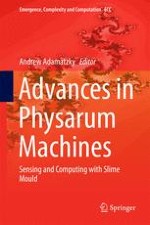2016 | OriginalPaper | Chapter
Towards Collective Visual Perception in a Multi-agent Model of Slime Mould
Author : Jeff Jones
Published in: Advances in Physarum Machines
Publisher: Springer International Publishing
Activate our intelligent search to find suitable subject content or patents.
Select sections of text to find matching patents with Artificial Intelligence. powered by
Select sections of text to find additional relevant content using AI-assisted search. powered by
